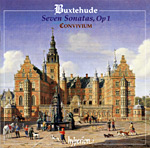The British trio Convivium offers welcome new performances of Dietrich Buxtehude’s Op. 1 sonatas, works that are increasingly gaining the recognition and recorded attention they’ve long deserved. Like the performances by the Boston Museum Trio on Harmonia Mundi and the John Holloway/Jaap ter Linden/Lars Ulrik Mortensen trio on Marco Polo, Convivium abstains from enlisting the aid of an optional second violinist, a common practice originating in Italy aimed at heightening improvisational effects when the composer called for such invention (as Buxtehude frequently does throughout these sonatas). In the notes Francis Knights argues that not only was the use of a single violin the norm for trio sonata performance in Germany at the time, it also afforded a finer delineation in timbre between the violin and gamba as well as enabled the gamba the liberty of doubling or elaborating the bass line and functioning as a solo instrument in the tenor range.
This is all well and good but the outcome ultimately makes for far less exciting and compelling music making. All you need do is compare Convivium’s performances to the ones offered by Manfredo Kraemer, Juan Manuel Quintana, Dane Roberts, and Dirk Börner on Harmonia Mundi (see review Q4867) as well as the Ensemble Baroque de Limoges’ performance of Sonata No. 4 on Astrée Naive (see review Q4780) to hear how critical the difference is. For instance, in the Fourth sonata’s opening Ciaccona Vivace, listen to the way Kraemer and Roberts cleverly propel the momentum of the piece, their instruments often echoing one another and heightening the expressive potential of the fugues. While fine, Convivium’s performance simply sounds undernourished and staid in comparison.
Perhaps the most revealing differences between approaches occur when both groups are called upon to navigate the treacherous Sixth sonata, where Buxtehude encourages extensive improvisation. Here Kraemer soars, at times complemented by Roberts’ second fiddle and at other times sheepishly not. In comparison, Convivium’s performance is far less thrilling regardless of violinist Elizabeth Wallfisch’s often sprightlier tempos and the imaginative support she receives from viola da gambist Richard Tunnicliffe.
Hyperion’s sound is very good, though at times the level of Paul Nicholson’s harpsichord strangely seems to rise and attenuate. The notes are informative and entertaining, though it should be mentioned that while on the tray card and in the booklet Richard Tunnicliffe is credited as playing the cello, he is actually performing on a viola da gamba.
































